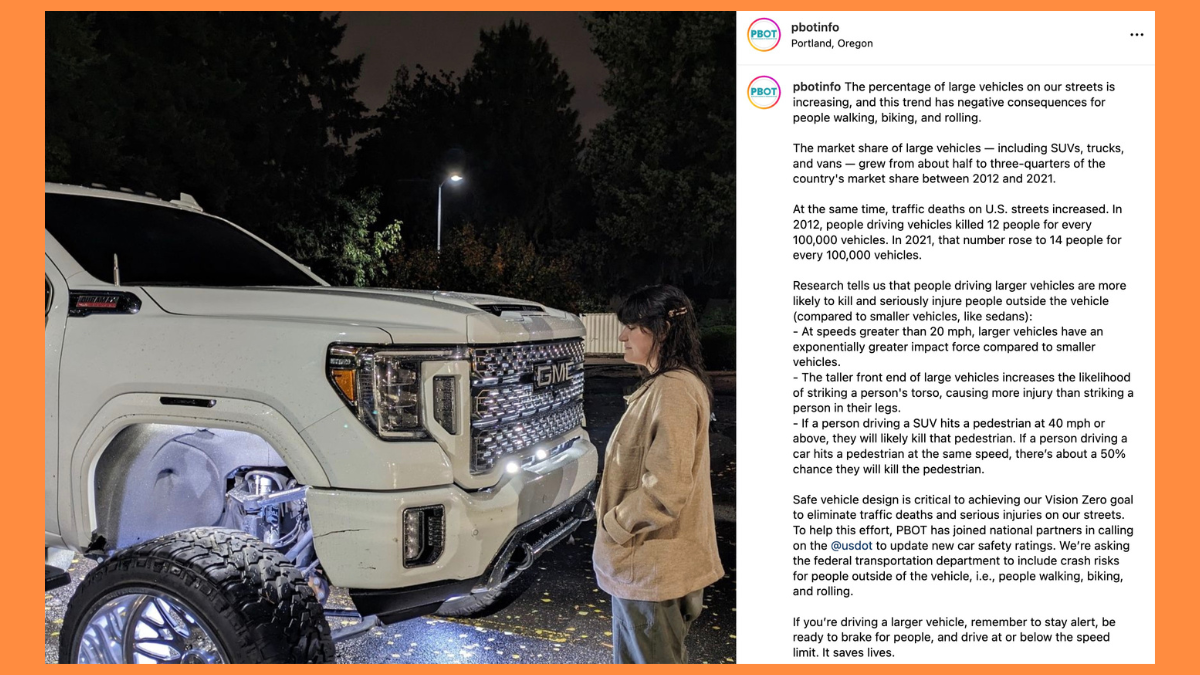
The massive size and aggressive design of many trucks and SUVs are making traffic crashes deadlier than ever. The issue has been around for years, but has gained considerable momentum of late. In 2019 we covered a talk in downtown Portland by author and activist Angie Schmitt where she said truck size is one of the major culprits for the rise in pedestrian deaths and then illustrated the problem with a photo of her 4-year-old son standing in front of a Ford truck. The boy’s head came up to the license plate.
As research and awareness have grown, the issue is now common in large national media outlets and has turned the corner into an issue that’s even safe enough even for government agencies to address head-on. One of those agencies is the Portland Bureau of Transportation.
Oversized trucks and SUVs are now a key part of PBOT’s “Safe Systems” approach to road safety. In their latest Vision Zero newsletter, PBOT draws a clear line from a rise in traffic deaths to “increasing vehicle size trends.” “More large vehicles are on our streets despite their disproportionate likelihood to kill and seriously injure people,” PBOT wrote in the newsletter, under a provocative photo of an adult woman staring into the grill of a jacked-up pick-up.
On Monday, they elevated the issue further, with posts to their social media accounts. With 153,000 views and counting on X (formerly Twitter) alone, PBOT is now fully engaged with this issue. But beyond the internet, what does all this mean for Portland and PBOT?
So far, when it comes to taking action, PBOT says they’ve joined a national campaign (led by the National Association of City Transportation Officials, or NACTO) to pressure the US Department of Transportation to update new car safety ratings to include crash risks for people outside of the vehicle. This is the same campaign I mentioned in coverage of this issue from the Vision Zero Cities Conference in New York City last week.
The other step PBOT has taken is to specifically call out a need for “safe vehicles” as one of the four elements central to their Safe Systems approach.
Identifying and embracing the issue as a priority are a necessary first step. But there’s much more PBOT can and should do to put actions behind their words. If PBOT understands the clear and present danger of these large vehicles, they have an even greater responsibility to design streets in a way that can withstand their impacts. This means less paint and plastic flex-posts, and more concrete separators, metal bollards, and so on.
It also means taking every opportunity possible to separate vulnerable road users from car and truck drivers — and not going in reverse by taking protection away just to satisfy complaints from business owners.
In their recent newsletter, PBOT gives us a hint about one step they could take: They could work with Multnomah County to increase vehicle registration fees for some SUVs and trucks. PBOT linked to an NBC News story about a new policy in Washington DC that would raise fees for vehicles weighing more than 6,000 pounds from $155 to $500. Given the desperate state of the PBOT budget, any reference to raising revenue — especially one backed by a safety goal — is notable.
The other place where PBOT can show us how committed they are is in how they handle their own fleet of vehicles and the vehicles used by contractors.

At a panel I attended at the Vision Zero Cities conference on Friday, New York City DOT Deputy Chief Fleet Management Officer Eric Richardson didn’t just speak passionately about the need for safer vehicle designs, he shared several concrete steps his agency has taken:
“We require telematics on all of our vehicles, we require high-vision truck cabs, we require pedestrian alerting and collision warning, we are working with manufacturers to try to redesign the vehicles so that when we are making vehicles heavier by electrifying them, we’re also trying to make them also safer…”
Richardson also said all 4,200 trucks in the NYC fleet have truck side underrun guards and that, thanks to a new city law, all contracted fleets will be required to have them too. On this front, PBOT has a good record. They currently say side guards are standard on all new heavy trucks purchased by the City of Portland since 2019. And all garbage and recycling contractors were required to have them by 2022.
The next step after truck design is speed management. Richardson said his current top priority issue is intelligent speed assist. New York City began a pilot program with the technology last year. PBOT has done great work on speed-related issues over the years; but to my knowledge, they have not delved into any speed limiting technology (I’ll update this post if I learn differently),
Asked at Friday’s panel to share one last word with the audience, Richardson chose to talk about speed limiting technology and how larger vehicles make it an even more important tool:
“Bring back from me to where you live, intelligent speed assist — ways to slow vehicles down so that they cannot go above the speed limit. One of my concerns is all the information that we have on speeds is based on current vehicle weight, and we need to make sure we’re keeping vehicles at or below the speed limit, because as they get bigger and become more dangerous, we’re going to see more fatalities at lower speeds. And so getting people down to the speed limit is really, really important.”



